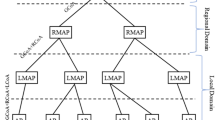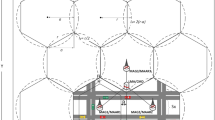Abstract
Mobile IPv6 (MIPv6) is considered inefficient to support mobility due to larger handover delay and signaling overhead. Therefore, Hierarchical MIPv6 (HMIPv6) is designed by introducing a Mobile Anchor Point (MAP) in the MIPv6 architecture. The MAP considerably drops the handoff delay and signaling load for mobility management in IPv6. The Three Layered MIPv6 (TLMIPv6), the focus of this paper, is influenced by the benefits of placing MAPs for efficient mobility management. In this model, three MAPs are placed in the architecture to reduce signaling cost and handoff latency. These MAPs are placed hierarchically in a tree like architecture, and the movement of nodes is coordinated by different MAP based on nodes’ movement patterns. The behavior of the proposed model is simulated under various traffic scenarios and mobility conditions and compared with MIPv6 and HMIPv6 and Flow Based Distributed Mobility Management (FBDM) protocols. The results depict that when users are less mobile or confined their movements to a small geographical area, the proposed TLMIPv6 outperforms MIPv6, HMIPv6, and FBDM in handoff latency and signaling costs. Some suitable application scenarios for adopting TLMIPv6 are also mentioned at the end of the paper. The future scopes of the work are outlined.

















Similar content being viewed by others
Explore related subjects
Discover the latest articles, news and stories from top researchers in related subjects.References
Balfaqih Z (2020) Design and development of network simulator module for distributed mobility management protocol. J Ambient Intell Humaniz Comput. https://doi.org/10.1007/s12652-020-01764-y
Balfaqih M, Balfaqih Z, Shepelev V, Alharbi SA, Jabbar WA (2020) An analytical framework for distributed and centralized mobility management protocols. J Ambient Intell Humaniz Comput. https://doi.org/10.1007/s12652-020-01749-x
Barkoosaraei AM, Hamid Aghvami A, Pangalos P (2014) Adaptive quality of service aware multi-mobility anchor point registration in hierarchical mobile IPv6 wireless access networks. IET Networks. https://doi.org/10.1049/iet-net.2012.0141
Calabuig D, Barmpounakis S, Gimenez S, Kousaridas A, Lakshmana TR, Lorca J, Lunden P et al (2017) Resource and mobility management in the network layer of 5G cellular ultra-dense networks. IEEE Commun Mag. https://doi.org/10.1109/MCOM.2017.1600293
Choi T, Kim L, Nah J, Song J (2004) Combinatorial mobile IP: a new efficient mobility management using minimized paging and local registration in mobile IP environments. Wireless Netw. https://doi.org/10.1023/B:WINE.0000023864.73253.b7
Cominardi L, Giust F, Bernardos CJ, De La Oliva A (2017) Distributed mobility management solutions for next mobile network architectures. Comput Netw. https://doi.org/10.1016/j.comnet.2017.04.008
Contreras LM, Bernardos CJ, Soto I (2011) RAMS: a protocol extension to pmipv6 for improving handover performance of multicast traffic. J Wirel Mobile Netw Ubiquitous Comput Dependable Appl.
Deering S, Hinden R (1998) RFC 2460—internet protocol, Version 6 (IPv6) Specification. Internet Requests for Comments.
Dutta N, Misra IS (2007) Mathematical modeling of hierarchical mobile IPv6 based network architecture in search of optimal performance. In: Proceedings of the 15th international conference on advanced computing and communications, ADCOM 2007.
Dutta N, Misra IS (2014) Multilayer hierarchical model for mobility management in IPv6: a mathematical exploration. Wireless Pers Commun. https://doi.org/10.1007/s11277-014-1825-9
Dutta N, Saha IM (2010) Test bed implementation of N-layered mobile ipv6 based network architecture in search of optimal performance. IEEE Globecom Workshop on Heterogeneous, Multi-hop Wireless and Mobile Networks Miami, USA
Dutta N, Saha IM, Majumder A (2010) Mathematical analysis of signaling overhead in MIPv6 based N-layer architecture. J Convergence Inform Technol 5(8). https://doi.org/https://doi.org/10.4156/jcit.vol5.issue8.28.
Dutta N, Misra IS, Safi MA, Pokhrel K (2012) Three layer MIPv6 (TLMIPv6): a new mobility management protocol for ipv6 based network. In: 2012 IEEE international conference on computational intelligence and computing research, ICCIC 2012. https://doi.org/https://doi.org/10.1109/ICCIC.2012.6510171.
Fogelstroem E, Jonsson A, Perkins C (2007) Mobile IPv4 regional registration. Internet Engineering Task Force (IETF) RFC 4857. 2007.
Ghaleb SM, Subramaniam S, Zukarnain ZA, Muhammed A (2018) Load balancing mechanism for clustered PMIPv6 protocol. EURASIP J Wirel Commun Netw. https://doi.org/10.1186/s13638-018-1137-y
Ghaleb SM, Subramaniam S, Ghaleb M, Ali ME, Ejmaa. (2019) An Efficient Group-Based Control Signalling within Proxy Mobile IPv6 Protocol. Computers. https://doi.org/10.3390/computers8040075
Gundavelli S (2020) Proxy Mobile IPv6. Encyclopedia Wirel Netw. https://doi.org/10.1007/978-3-319-78262-1_14
Hussain A, Nazir S, Khan S, Ullah A (2020) Analysis of PMIPv6 extensions for identifying and assessing the efforts made for solving the issues in the PMIPv6 domain: a systematic review. Comput Netw. https://doi.org/10.1016/j.comnet.2020.107366
Johnson D, Ce Perkins, Arkko J 2004. RFC 3775—Mobility Support in IPv6. IETF, June.
Kadusic E, Zivic N, Kos A (2016) QoS-Aware dynamic MAP selection in HMIPv6 architectures. IEEE Access. https://doi.org/10.1109/ACCESS.2016.2575098
Kawano K, Kinoshita K, Murakami K (2002b) A multilevel hierarchical distributed IP mobility management scheme for wide area networks. Proc—Int Conf Comput Commun Netw ICCCN. https://doi.org/10.1109/ICCCN.2002.1043109
Kawano K, Kinoshita K, Murakami K (2002a) A mobility-based terminal management in ipv6 networks. IEICE Transactions on Communications.
Kawano K, Kinoshita K, Murakami K (2004) Multilevel hierarchical mobility management scheme in complicated structured networks. Proc Conf Local Comput Netw LCN. https://doi.org/10.1109/LCN.2004.83
Koodi R (1989) Mobile IPv6 fast handovers. J Chem Inform Model.
Lee JH, Chung TM, Gundavellit S (2008) A comparative signaling cost analysis of hierarchical mobile Ipv6 and proxy obile Ipv6. IEEE Int Symp Personal Indoor Mobile Radio Commun PIMRC. https://doi.org/10.1109/PIMRC.2008.4699416
Leiter Á, Bokor L (2019) A Flow-based and operator-centric dynamic mobility management scheme for proxy mobile IPv6. Wirel Commun Mob Comput. https://doi.org/10.1155/2019/4567317
Nashaat H, Rizk R (2015) Handover management based on location based services in F-HMIPv6 networks. KSII Trans Internet Inf Syst. https://doi.org/10.3837/tiis.2015.12.016
Perkins C (2013) RFC 5944: IP mobility support for IPv4, Revised. Ad Hoc Networks.
Postel J (1981) RFC 791: Internet Protocol. Ietf Rfc 791.
Rajput S, Bhatia KS (2021) Self organizing distributed mobility management for next generation mobility protocol. J Ambient Intell Humaniz Comput. https://doi.org/10.1007/s12652-020-02770-w
Rajput S, Nidhi (2019) A study of vehicular adhoc networks. In: Proceedings—2019 international conference on computing, communication, and intelligent systems, ICCCIS 2019. https://doi.org/https://doi.org/10.1109/ICCCIS48478.2019.8974462.
Ramjee R, Varadhan K, Salgarelli L, Thuel SR, Wang SY, La Porta T (2002) HAWAII: a domain-based approach for supporting mobility in wide-area wireless networks. IEEE/ACM Trans Netw. https://doi.org/10.1109/TNET.2002.1012370
Rehmani MH, Saleem Y (2014) Network simulator NS-2. Encyclopedia Inform Sci Technol Third Edition. https://doi.org/10.4018/978-1-4666-5888-2.ch615
Shankar A, Sivakumar NR, Sivaram M, Ambikapathy A, Nguyen TK, Dhasarathan V (2020) Increasing Fault Tolerance Ability and Network Lifetime with Clustered Pollination in Wireless Sensor Networks. J Ambient Intell Humaniz Comput. https://doi.org/10.1007/s12652-020-02325-z
Soliman H.; Catelluccia C; ElMalki K. and Bellier L. 2008. “Hierarchical Mobile IPv6 (HMIPv6) Mobility Management.” IETF RFC5380.
Wang S, Cui Y, Das SK, Li W, Jianping Wu (2011) Mobility in IPv6: Whether and How to Hierarchize the Network? IEEE Trans Parallel Distrib Syst. https://doi.org/10.1109/TPDS.2011.71
Wikipedia (2005) Domain name system. Software World. https://doi.org/10.1201/9781420000030-21
Xu Yi, Lee HCJ, Thing VLL (2003) A local mobility agent selection algorithm for mobile networks. IEEE Int Conf Commun. https://doi.org/10.1109/icc.2003.1204523
Funding
No funding was received to assist with the preparation of this research.
Author information
Authors and Affiliations
Contributions
ND: involved the algorithm analysis, design and results parts. HKDS: involved in analysis and organization of the results and overall paper structure.
Corresponding author
Ethics declarations
Conflict of interest
The authors have no conflicts of interest to declare that are relevant to the content of this article.
Financial interests
All authors certify that they have no affiliations with or involvement in any organization or entity with any financial interest or non-financial interest in the subject matter or materials discussed in this manuscript.
Additional information
Publisher's Note
Springer Nature remains neutral with regard to jurisdictional claims in published maps and institutional affiliations.
Appendices
Appendix 1: Procedures


Appendix 2: List of abbreviations and acronyms

Rights and permissions
About this article
Cite this article
Dutta, N., Sarma, H.K.D. Efficient mobility management in IP networks through three layered MIPv6. J Ambient Intell Human Comput 13, 3209–3227 (2022). https://doi.org/10.1007/s12652-021-03158-0
Received:
Accepted:
Published:
Issue Date:
DOI: https://doi.org/10.1007/s12652-021-03158-0




